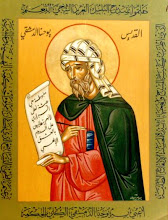On the Canon and the Katavasiae; the Kontakion, the Ikos and the Synaxarion
The second half of Orthros begins with the Canon.
The canon versus the Katavasia
A Canon is a set of hymns divided into nine sections, called odes. The second ode, traditionally dealing with the sinful need for repentance, is commonly omitted. Each ode begins with a hymn referred to as the Hirmos. The Hirmos (plural, “hirmi”) is the model hymn which sets the basic melody for the other hymns of the ode. How the Hirmos is chanted becomes the easy pattern for the remaining hymns of the ode (although this somewhat depends on the translation).
At the end of the ode the Hirmos is repeated, and referred to as the Katavasia (literally meaning “coming or sitting down”, plural “Katavasiae”). The term originated in monastic settings or larger churches in which two groups of chanters would chant the canon antiphonally. At the end of an ode, both groups would descend to the center of the solea and repeat the Hirmos together, the one group then sitting down while the other group stood to chant the next ode.
There are typically, two canons found in the Octoechos for each Sunday, the second usually focusing on the Incarnation of Christ. If either or both are chanted in entirety, short litanies follow the third and sixth ode. However, in typical parish practice, usually only the Katavasia are chanted.
The reduction of the canon to the Katavasia has led to particular Katavasiae being used seasonally. The Katavasia of the Canon of the Akathist Hymn, like the Kontakion “O Never-failing Protectress”, has come to be used for much of the year, with Katavasiae related to other particular feasts being substituted periodically. While this has the advantage that the Katavasia, having the characteristics of idiomela, becomes more easily recognized and sung by worshippers, the disadvantage is that the various canons in the Octoechos and Menaia are seldom if ever heard. Given their rich theological content, this is lamentable.
The Kontakion and the Ikos
While the reduction of the Canon to the Katavasia presents the issue of completeness and adherence to Tradition versus expeditiousness, it also raises a practical issue regarding the Kontakion, Ikos and Synaxarion. These are typically found after the sixth ode of a fully chanted Canon. If the full Canon is not chanted, in many places the Kontakion, Ikos and Synaxarion are simply omitted. A better practice is to include the Kontakion, Ikos and Synaxarion immediately before the Katavasia.
The Kontakion and Ikos are the first hymns of what once were much longer compositions (the old “Kontakia”), which were theological reflections on particular holy days and formed an important element of the “cathedral” office. Kontakia emphasized important theological points of the particular holy day, in the manner of a poetic reflection. The Ikos (plural, “Iki”) expanded on the theme of the main Kontakion. Typically, the final words of the Kontakion are also the final words of the Ikos.
In addition to the role of the Kontakia in the Octoechos and in the Menaion, some Kontakia have also come to function as “seasonal hymns” at the Divine Liturgy. In that capacity, a Kontakion will anticipate a Feast, like the Kontakion in anticipation of the Nativity of our Lord, or the Kontakion of the Cross, etc. The insertion of a particular Kontakion in the Liturgy reminds the worshippers of upcoming Feasts and important seasons.
The Synaxarion
The Synaxarion is a short reference to the saint or event commemorated on a particular day. In modern usage, a simple reference that on such a day, saint so-and-so is commemorated is followed by a brief poetic comment indicating something about the life of the saint, concluding with an intoned petition for God’s mercy through the prayers of the saints.
While this is all that remains liturgically of the Synaxarion in Orthros, the Synaxarion (“book of coming together”) is properly the collection of the lives of the saints celebrated on each day of the calendar year. On any given day, several saints or holy events will be noted in detail. Consequently, published Synaxaria, or Synaxaristes, typically are multi-volume collections. These theologically rich biographies detail not only the simple life of the saint, but the theological implications of various events as well. At one time, readings from the Synaxarion formed a lengthy and regular part of the divine worship of the Church. Nowadays, while the abbreviated references in Orthros are the main liturgical legacy of this practice, the materials of the Synaxarion are available in several editions, including several English language editions, and are sources of inspiration and teaching for many of the faithful.
Again, if the full Canon is not chanted, the Kontakion, Ikos and Synaxarion may precede the Katavasia. In either option, after the chanting of the eighth ode of the Canon (or the eighth Katavasia), the hymn of the Virgin Mary known in the West as the Magnificant interrupts. This hymn (a “Megalynarion”), announced by the deacon, is sung with a refrain while the deacon performs a great censing of the Church. After the Megalynarion, the final ode or Katavasia is chanted.
Subscribe to:
Post Comments (Atom)


No comments:
Post a Comment